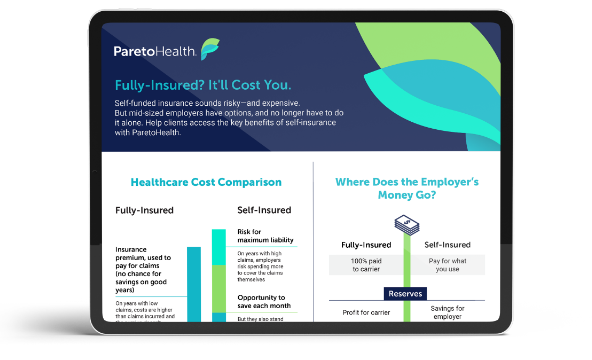What is a fully-insured health plan?
A fully-insured health plan is one of the common, traditional types of employer-sponsored healthcare. Employers pay monthly premiums that are recalculated on an annual basis. This calculation is based on the number of plan members, their previous claims history, and the policy structure.
It is also highly inefficient and, in almost all cases, a bad choice for smaller employers.
The phrase “fully insured plan” should go down in history as one of the most effective pieces of marketing writing to ever exist. It’s designed to make the term seem nice and comprehensive, but it hides far more than it reveals.
It’s not “full” – at least, it’s not full of anything good – and it’s not as much insurance as it is a deferral of payment.

But before we get too far into it, let’s talk about its basic structure.
Honestly, the politest way of describing this fully insured model is “insurance as a service.” In exchange for a certain amount of money within a 12-month period, your plan costs will not go above that amount. The carrier takes on the risk, and you provide an agreed-upon amount of money that makes this arrangement make sense to them.
To understand what we mean, take a look at it from the carrier’s perspective.
They have a number of policies on their books, and they have to make sure that these policies are profitable. While they make payments for the claims that your employees submit to them, they are reassessing the risk that your policy represents.
If you have a good year (meaning that your claims are less than the amount of premium you pay), then the carrier often provides you a flat increase (meaning you pay the same next year as you did the previous year) or a small increase, reflecting the normal process of inflation.
This means that, in a good year, the plan sponsor ends up overpaying for their coverage by definition. It is vanishingly rare for the following year to include any substantial reduction in costs.
Of course, you could also have a bad year in which your claims are higher than the premium you pay. This is, of course, the point of having insurance: it is for unforeseeable and expensive contingencies.
The year after a bad one, though, the plan sponsor on a fully-insured plan is very likely to have to pay a significant increase in their premium. The logic behind this, from the carrier’s point of view, is sound in a certain sense. They were taking on a risk that turned out to be higher than they had initially calculated, and they have the right to increase that premium in light of the newfound risk.
This means, effectively, that you are not so much insuring your risks as you are deferring payments for them into next year. After a good year, you pay a small increase. After a bad year, you pay a big one.
In addition, any increase you receive becomes part of your new status quo. Generally, we have found that most employers face around one bad year in every five. You should be able to take as much advantage of those good years as you can while also having the protection that you need during a bad year that could otherwise prove an unsustainable expense. Having to pay for one year’s bad claims in perpetuity is not the way of solving this problem.
This has led to a phrase that we use at ParetoHealth to describe fully-insured plans: deferred, not insured. Companies in this type of funding arrangement are essentially self-funded but with some key differences: paying for last year’s claims instead of this year’s, zero visibility into what is driving these costs, and much less flexibility in plan design.
We’ve already gone over the first of these. The second is also crucial: almost no fully-insured plans will provide data on the types of claims driving your costs. This impact can be significant since you cannot control what you cannot measure.
How do you know, for instance, whether your high costs for your previous plan year were driven by surgical or pharmacy claims? If you knew, then you could put measures into place that would not only reduce your costs but also improve the quality of care that your employees received. Under a fully-insured plan, this is next to impossible. The only cost-saving measures available under the vast majority of fully-insured plans are those that reduce the quality of your benefits offering. If your goals include attracting and retaining talent, then this is quite clearly not the best option.
Third, we come to the issue of plan design. Fully-insured plans are much more heavily regulated than other types of benefits programs. This, taken with the lack of transparency into the claims that are driving your costs, means that it is nearly impossible to tailor your benefits around what your employees actually need. This lack of flexibility and the impossibility of an individualized approach is another mark against this type of plan.
The carrier also has to price policies based on how their book of business is performing. This term refers to all of the policies that they have written.
Simply put, pricing for your policy isn’t just about you—it’s also about all the other groups the carrier is covering. You share the same risk pool with every other group your carrier covers, like it or not.
Beyond that, the reassessment process is often opaque, but the one thing you can almost always depend on is your rates going up.
The core of this business model is about the balance of risk and reward, where only you take on the risk while the carrier pockets the reward. So, if you have $0 in claims, your premium goes into their profit margin, but your premiums still rise after any bad year that strikes. You just can’t win. Said differently, “The house always wins.”
Does that seem fair to you?
It always seemed unfair to us.
There’s a Better Way to Do Employee Health Benefits
Join an upcoming webinar to learn how ParetoHealth turnkey employee health benefits solutions deliver the scale and resources mid-sized businesses need to self-insure with total confidence. By combining a captive model with comprehensive medical and pharmacy cost containment strategies, our members realize significant cost savings with multi-year protection.
 December 5, 2023
December 5, 2023 






